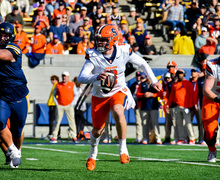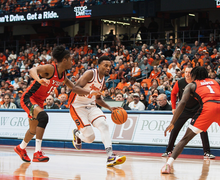A running program and lower-body workouts contribute to Sondre Norheim’s breakout season
Max Freund | Asst. Photo Editor
Sondre Norheim defends against the Bonnies. He's added an offensive element to his game this season.
After Syracuse’s 3-0 win against Ohio State on Oct. 8, SU head coach Ian McIntyre worried about his team’s fitness. SU had just won its third-straight game in seven days, its best stretch of the season, yet McIntyre noticed tired legs in the second half. McIntyre grew a little concerned when he analyzed Sondre Norheim, his “barometer” of team stamina.
Coaches have called Norheim a “cheetah.” McIntyre refers to him as Forrest Gump, because he can’t seem to stop running. Norheim, though, lagged behind the run of play against the Buckeyes, and that couldn’t happen again. After a day off, Norheim went to the Cage, a gym for athletes in Manley Field House. He cleared his personalized regimen of squats, lateral lunges and other leg lifts. And then he headed to a team practice.
“I always try to push my body as much as possible as long as it doesn’t disturb my performance,” Norheim said.
Norheim, a 6-foot-4 defender, has been described by teammates as a “consummate professional.” His consistency — he’s been a starter for all but one of SU’s matches in the last two years — and production are contributing factors as to why No. 20 Syracuse (7-5-3, 1-4-2 Atlantic Coast) is sixth in the NCAA’s rating percentage index. In 2018, the defender is second on the team with five goals. In 2017, he attempted three shots. Since Oct. 16, he scored three times.
A center back last year, Norheim shifted to right back for the 2018 season. He will be a big factor in the Orange’s season-finale against Boston College on Friday, Oct. 26. The matchup against the Eagles represents a chance for SU to pull itself out of the bowels of the ACC before the conference tournament begins next Wednesday.
“If you ask anyone, it’s very difficult for Sondre to improve his fitness. He’s a machine,” McIntyre said. “… If he’s tired, it’s not a reflection of weakness in his game, it’s more a, ‘Wow, we must be working hard and that’s a lot of soccer.’”

Laura Angle | Digital Design Editor
Norheim works out his lower body two times a week, he said. He compliments that with a running program which he and Corey Parker, a member of SU’s strength and conditioning team, developed.
Adding to his leg workouts, Norheim completes a third training session, stretches, and then practices game-specific ball drills. When he got to Syracuse a year ago, Norheim embraced the athletic training facilities, like the leg press machine. They were a step up from the equipment he used back home in Bryne, Norway.
“I think I’ve had a (dedication) to lifting for a long time before Syracuse,” Norheim said. “I’ll always try to contribute individual workouts on top of team workouts.”
In Norway, Norheim played one game a week, allowing more time for workouts. He committed himself to at least eight hours of sleep a night since he was five years old. On the field, he had five to six practices a week, Norheim said, usually at about 5 p.m. This established the mornings as Norheim’s designated gym time.
When he returned home this summer, he joined the same adult league he was a part of in high school. The experience once matured Norheim, but now he found himself faster than other players. High-intensity ACC matchups had prepared Norheim. He processed the game quicker.
Unchallenged defensively, Norheim added an old dimension to his game: attacking. Norheim was predominantly a right-back in his teenage years before he grew into his 180-plus pound, 6-foot-4 frame.
“I got the height and build to fit at center back,” Norheim said. “Sometimes the team didn’t have enough center backs to play this game, and I may have to step in.”
But on Aug. 24, before SU’s season-opener against Oregon State, McIntyre approached Norheim and said he’d start the year at right back. OSU had a talented left forward that excelled at one-on-one playmaking. Norheim’s speed, hopefully, would be a counter. It was, and SU won 2-1.
After the game, McIntyre, who earlier this season said the goal is to get as many players forward as possible, realized that Norheim added a layer to an offense that relied on speedy forwards. SU’s offense is predicated on playmakers in the midfield — Jonathan Hagman, Hugo Delhommelle and Massimo Ferrin — launching the ball upfield to forwards Tajon Buchanan and Ryan Raposo.
Norheim said he recognizes the flow of the game, and as the defense clamps down on the dribbler, he shoots his hand up and sprints down the right sideline, providing an outlet. From there, Norheim can sky crosses into the box, or pass it off and work his way into the penalty box for a header.
“(Norheim)’s really fast and can run forever,” Hagman said. “He’s been showing a lot of soccer quality as well, but there are points he really stands out and has been fantastic.”
Against St. Bonaventure on Oct. 16, Norheim bookended the 7-0 rout with two goals. The first came off a corner kick, which was earned by Norheim pressing higher and forcing a defender to mishit the ball. On the receiving end of a Delhommelle service, Norheim knocked the ball past the post.
The second score came with five seconds left, SU’s only last-second goal this season. A scrum near the Bonnies’ net allowed Norheim to blast one home. Norheim entered the season with offensive potential, and just ahead of the postseason, he’s actualized it.
“If you’re doing those runs up and down the field,” Norheim said, “you want to get something out of it.”
Published on October 24, 2018 at 11:03 pm
Contact Nick: nialvare@syr.edu | @nick_a_alvarez





